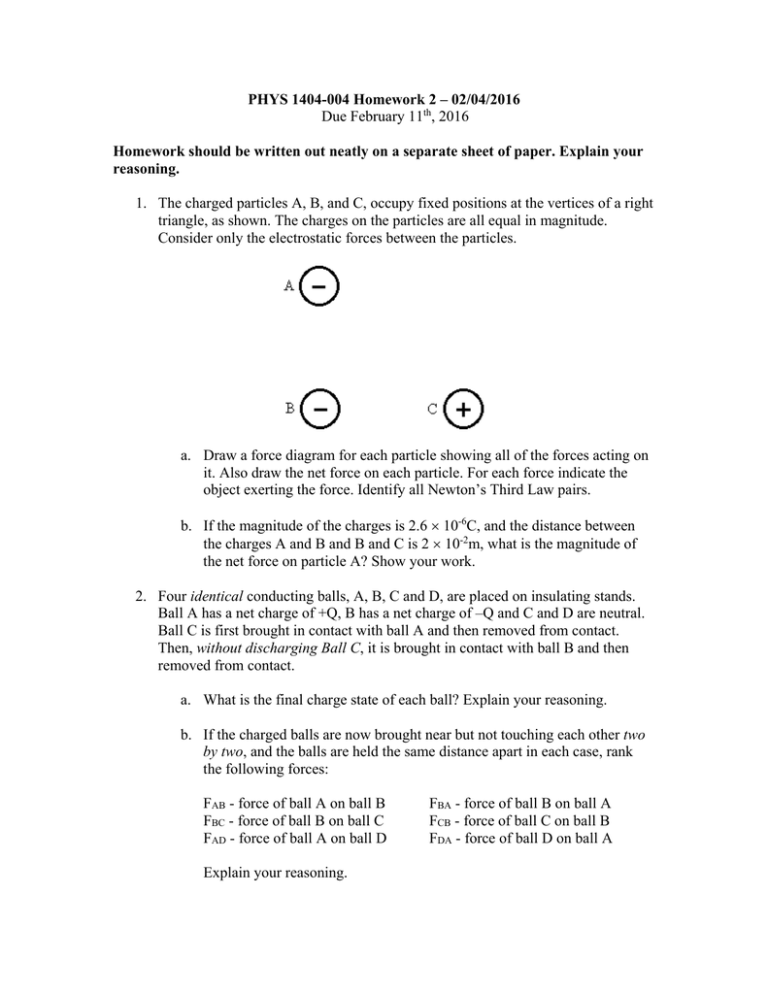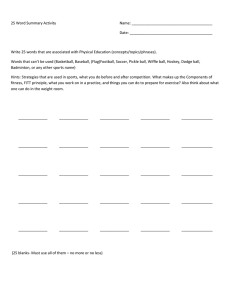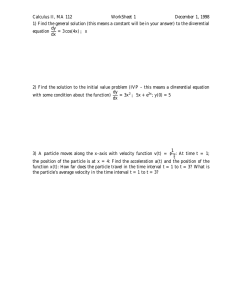PHYS 1404-004 Homework 2 – 02/04/2016 Due February 11 , 2016
advertisement

PHYS 1404-004 Homework 2 – 02/04/2016 Due February 11th, 2016 Homework should be written out neatly on a separate sheet of paper. Explain your reasoning. 1. The charged particles A, B, and C, occupy fixed positions at the vertices of a right triangle, as shown. The charges on the particles are all equal in magnitude. Consider only the electrostatic forces between the particles. a. Draw a force diagram for each particle showing all of the forces acting on it. Also draw the net force on each particle. For each force indicate the object exerting the force. Identify all Newton’s Third Law pairs. b. If the magnitude of the charges is 2.6 × 10-6C, and the distance between the charges A and B and B and C is 2 × 10-2m, what is the magnitude of the net force on particle A? Show your work. 2. Four identical conducting balls, A, B, C and D, are placed on insulating stands. Ball A has a net charge of +Q, B has a net charge of –Q and C and D are neutral. Ball C is first brought in contact with ball A and then removed from contact. Then, without discharging Ball C, it is brought in contact with ball B and then removed from contact. a. What is the final charge state of each ball? Explain your reasoning. b. If the charged balls are now brought near but not touching each other two by two, and the balls are held the same distance apart in each case, rank the following forces: FAB - force of ball A on ball B FBC - force of ball B on ball C FAD - force of ball A on ball D Explain your reasoning. FBA - force of ball B on ball A FCB - force of ball C on ball B FDA - force of ball D on ball A 3. Two identical pith balls are hung by insulating strings, touching each other, as in the picture below. The mass of each ball is 0.002kg. The strings are 28cm long. The two balls, while touching each other, are touched simultaneously to a charged rod. After they are touched by the rod, they move apart. The angle between the strings is eight degrees, as shown in the diagram below. Determine the charge on each ball. Show your work and explain your reasoning. 4. At what distance between point charge 𝑞𝑞𝐴𝐴 = 26.0 𝜇𝜇𝜇𝜇 and point charge 𝑞𝑞𝐵𝐵 = −47.0 𝜇𝜇𝜇𝜇 will the electrostatic force between them have a magnitude of 5.70 N? 5. In the figure, a particle of charge 𝑞𝑞1 = +4𝑒𝑒 is above a floor by distance 𝑑𝑑1 = 2.0 𝑚𝑚𝑚𝑚 and a particle of charge 𝑞𝑞2 = +6𝑒𝑒 is on the floor at horizontal distance 𝑑𝑑2 = 6.0 𝑚𝑚𝑚𝑚 from the first particle. What is the x-component of the electrostatic force on the second particle due to the first particle? 6. In the figure, 𝑞𝑞1 = +𝑞𝑞, 𝑞𝑞2 = −𝑞𝑞, 𝑞𝑞3 = +2𝑞𝑞, and 𝑞𝑞4 = −2𝑞𝑞. What are the (a) horizontal and (b) vertical components of the net electrostatic force on the charged particle in the lower left corner of the square if 𝑞𝑞 = 1.0 × 10−7 𝐶𝐶 and 𝑎𝑎 = 5.0 𝑐𝑐𝑐𝑐? 7. In the figure, two tiny conducting balls of identical mass 𝑚𝑚 and identical charge 𝑞𝑞 hang from nonconducting threads of length 𝐿𝐿. Assume that 𝜃𝜃 is so small that tan 𝜃𝜃 can be replaced by its approximate equal, sin 𝜃𝜃. Show that, for equilibrium, 2𝑘𝑘𝑞𝑞 2 𝐿𝐿 𝑥𝑥 = � 𝑚𝑚𝑚𝑚 � 1⁄3




